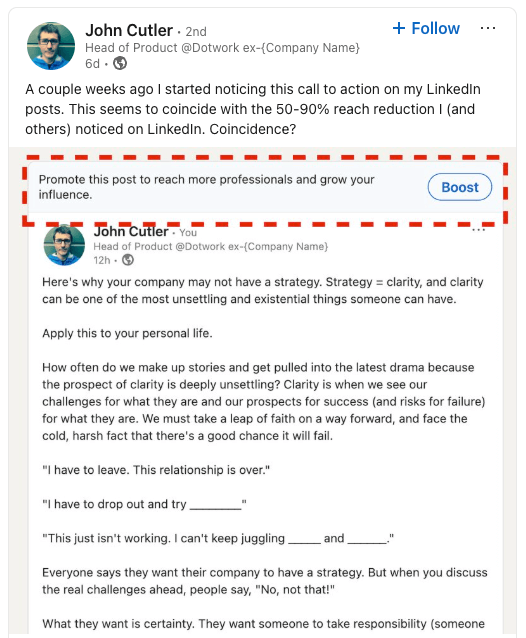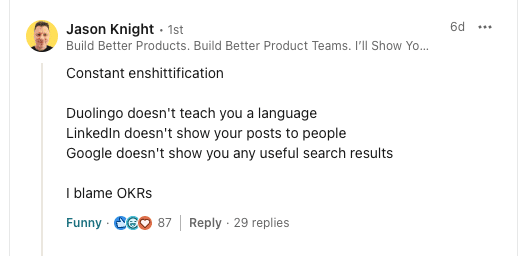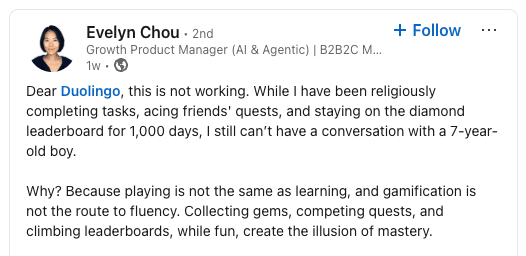Fighting the Enshittification of Products: Why Good Products Go Bad and What to Do About It
Most of us have felt the creeping dread when a product we once loved starts to suck. The features that drew us in get buried. Pop-ups appear out of nowhere. The thing that “just worked” now demands three extra clicks or your credit card. A once-great product is slowly, inexorably being ruined. There’s a word for this, and it’s not subtle: enshittification. And there are plenty of enshittification examples out there in the wild.
Cory Doctorow coined the phrase enshittification, but it’s gone viral (and became the 2024 word of the year!) because it so perfectly captures what we’re all experiencing in real time, everywhere from social media to SaaS to search.
Is it full product failure? No. It’s more subtle than that. It’s slow and steady…well….getting shit.
But here’s the bigger question: Why does this happen, and what can we do about it as product people, the so-called last line of defense before our users get hurt?
What is Enshittification?
Enshittification is the slow (or sometimes not-so-slow) process by which once-great products are gradually ruined: bloated with ads, riddled with dark patterns, and reshaped to extract more value from users at the expense of trust, utility, and joy.
It’s when a company trades long-term user love for short-term metrics or revenue, and the soul of the product quietly dies by a thousand cuts.
Enshittification Examples: The Problem in Action
Enshittification is happening in the open, all around us. Sometimes in small ways. Sometimes in ways that are impossible to ignore. Let me share just a few of my favorite 🫠 enshittification examples…
Enshittification Example 1: LinkedIn’s Pay-to-Play Reach (aka: Did You See My Post? No, Really…)
Just a couple days ago, John Cutler posted on LinkedIn that his posts, and those of many others, were suddenly reaching far fewer people (like 50–90% fewer). Right at the same time, LinkedIn started showing a juicy new call to action: “Promote this post to reach more professionals.”

You know, pay if you actually want your audience to see what you wrote. Coincidence? Or a classic case of the product you use being refactored, behind the scenes, to squeeze you just a little harder? An enshittification example, I think you’ll agree.
Jason Knight, another voice in product, nailed it in a reply:

Duolingo doesn’t teach you a language
LinkedIn doesn’t show your posts to people
Google doesn’t show you any useful search results
I blame OKRs
This isn’t just one product, or one industry, it’s everywhere. As soon as a product hits scale, the incentives shift, and enshittification starts seeping in.
Enshittification Example 2: Duolingo – Gamification > Learning
If you’ve used Duolingo lately, you know the game. The streaks, badges, leaderboards… so much dopamine, so little language learning.
Read Evyln Chou’s article on how her 1000 day streak didn’t leave her any better off at speaking a new language:

A recent study even found Duolingo’s gamified mechanics can end up distracting users from actual progress, making the whole thing more about playing the system than learning Spanish.
It’s a classic: start with authentic value, then lose the plot as you chase daily engagement at all costs.
Enshittification Example 3: Google Search – SEO Decay and the Rise of Ads
Remember when Google helped you find the answer to your question? Now you get a wall of ads, then AI-powered summaries of questionable quality, and maybe, if you scroll, you’ll see a real answer. The best content? Buried by algorithmic preference for what’s “engaging”… or what’s paid.
Enshittification Example 4: SaaS Tools – More for Less (or Less for More)
Even in SaaS, enshittification is alive and well. Features move behind paywalls. “Free” tiers get gutted. Roadmaps start chasing expansion revenue instead of solving core user problems.
We see it in our own community. Product Managers are pressured to add pop-ups, lock out features, or mess with the UX in ways that help the bottom line, but hurt the people who trusted us in the first place.
How Enshittification Happens (and why it’s systemic)
So why do good products go bad? It’s not usually because the people building them are bad, or because everyone secretly wants to trick users.
It’s the system. The incentives. (It’s always the incentives.) The slow creep of “just one more little optimization for growth” until the product isn’t really for users anymore, it’s for advertisers, investors, or the next OKR cycle.
The Lifecycle of Enshittification
You’ve heard of the product lifecycle of course. So where on that journey are products (and the teams that build them) susceptible to slipping down the slope of enshittification? It usually goes a little something like this:
- Birth: Build something people love. Listen to users. Growth is organic.
- Growth: Monetize. Start optimizing for engagement, retention, revenue.
- Drift: Shortcuts sneak in. Metrics become gospel. Internal incentives quietly shift from value creation to value extraction.
- Decline: Trust erodes. Product becomes a shadow of itself. Users disengage, or worse, pay more for less.
The tragedy is, it rarely happens all at once. It’s the slow-boil effect. A tweak to the algorithm here, a pop-up there. You barely notice, until you do.
The Product Manager’s Dilemma
Here’s the dirty secret: product people are often the ones caught in the middle. We see the trade-offs up close:
- Ship a feature that “boosts conversion” but erodes trust?
- Add friction so people will “upgrade”?
- Prioritize something leadership wants, even when you know it makes things worse for real users?
I’ve been there. We all have. Sometimes it’s a battle just to keep the user front and center, when every incentive in the company is pushing you to make the dashboard numbers move, no matter the cost.
It’s exhausting! And it takes guts to say no, or at least to ask: “What problem are we actually solving here? For whom?”
Why Do We Let Enshittification happen?
I believe in the goodness of product people 😇, so why are there so many enshittification examples out there? What is it that causes us to slip into these bad habits? For the most part, it’s:
- Short-term thinking: Quarterly targets, OKRs, and “what’s the number this week?”
- Metrics worship: If it’s measurable, it’s “good.” Never mind if it’s meaningful.
- Misaligned incentives: The real customer becomes the advertiser, the investor, the next funding round.
- Loss of product vision: Forgetting what made the product great in the first place.
The bigger a company gets, the harder it is to resist. It’s no accident that enshittification examples happen fastest after IPOs, big rounds, or leadership changes.
How Do We Fight Back Against Enshittification?
If you’re reading this, chances are you’ve felt that sinking feeling in a product meeting, too. The good news? There’s a way to push back and avoid your product becoming one of the enshittification examples I add to this article when I come to update it in 6 months 😜
1. Build (and Defend) a Strong Product Vision
Be crystal clear about who your product is for, and what you stand for. Write it down. Use it as a shield. When the “what if we just add a pop-up” suggestion comes up, you can point to the product vision and say: “That’s not us.”
Need to nail down your Vision? Use our free template
2. Obsess Over Real User Value
Don’t let engagement, streaks, or vanity metrics become the goal. Ask what actual problems you’re solving, and measure trust, satisfaction, and retention as your north stars.
3. Track Ethical Metrics
It’s not enough to track usage. Are users better off because they used your product? Track things like Net Promoter Score, support tickets, retention, even qualitative stories from customers.

4. Use Your Influence
Speak up. Show leadership what’s at stake, not just this quarter, but for the company’s reputation and long-term health. Sometimes, the most valuable thing a product person can do is say “no”.. or at least, “not this way.”
5. Tell the Truth About Trade-Offs
Bring stories, data, and real user feedback to the table. Show the cost of dark patterns, friction, and broken promises. Make it impossible to ignore.
6. Celebrate (and Share) Small Wins
It’s not all doom and gloom. Share stories of when you or your team did hold the line, said no to a bad incentive, or built something users genuinely loved, even if it wasn’t the “highest converting” thing.
Enshittification is a Choice
Enshittification isn’t inevitable. It’s a choice. A thousand tiny choices made every day. As product people, we have more power than we think to slow it down, call it out, and maybe, just maybe, stop it in its tracks.
But it means being loud. Being annoying. Asking the uncomfortable questions. (“What problem are we really solving?”) It means being okay with leaving some money on the table if it means keeping the trust of your users.
Over to you: Hold the line
So here’s my challenge to you, fellow product folks:
- Where have you seen enshittification creep into your products or industry?
- What’s the most egregious example you’ve experienced?
- And most importantly: what did you do about it.. or wish you had?
Drop your stories, wins, losses, and spicy takes in the comments. Let’s make some noise, compare notes, and remind each other why we do this job in the first place.
We are the last line of defense before the user gets hurt.
Let’s not be the ones holding the shovel.

Great article.
I am presently working on a project to -de-crapify their product.
Thankfully, I have Prune the Product Tree at my disposal. Not “add more crappy features to my bloated product for the wrong reasons” Product Tree.
Pruning is liberating. And it helps deal with this problem directly.
I wish more roadmapping processes / templates would celebrate the *removal* of features.
Ah I love the Prune the Product Tree exercise! Yes, perfect way to figure out what can go that’ll be beneficial to the product as a whole.
One of the ways I like to encourage pruning is to think about work in terms of experiments: We all know we’re supposed to run a bunch of experiments against problems in order to figure out what’s going to make the biggest impact.. but the trick with experiments is to widen your usual definition of them (and it’s not just A/B tests!) For example, an experiment might be to add a feature… but just as well, the experiment could be to remove a feature, or change a feature, or not even be related to a feature at all (could be a test in pricing, packaging, proposition, etc). That way, the roadmap isn’t just a list of new features to build, but a series of experiments that could add and remove and adjust the product in a bunch of ways!